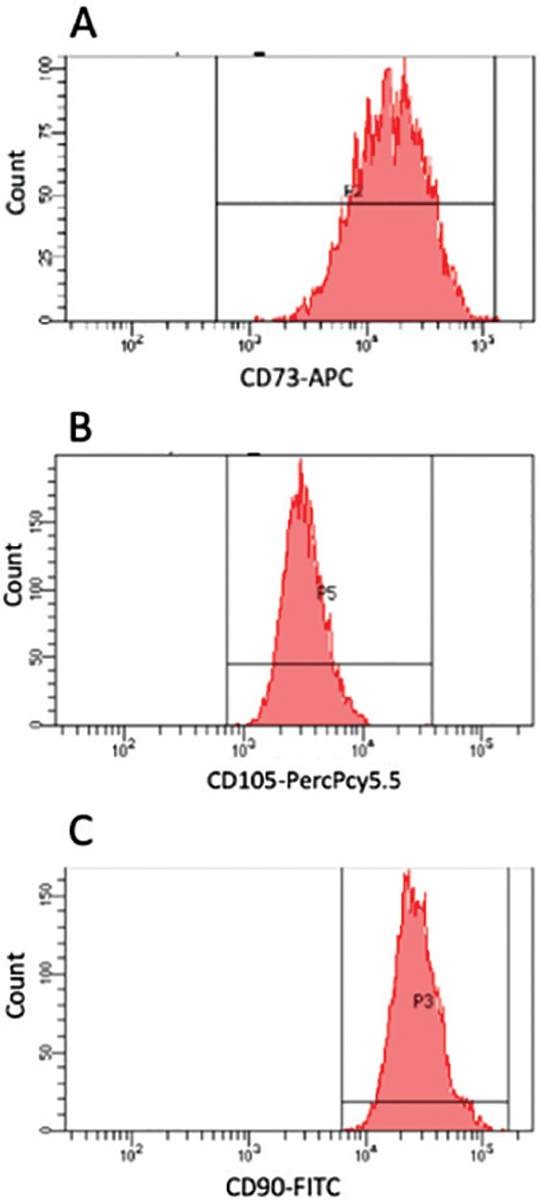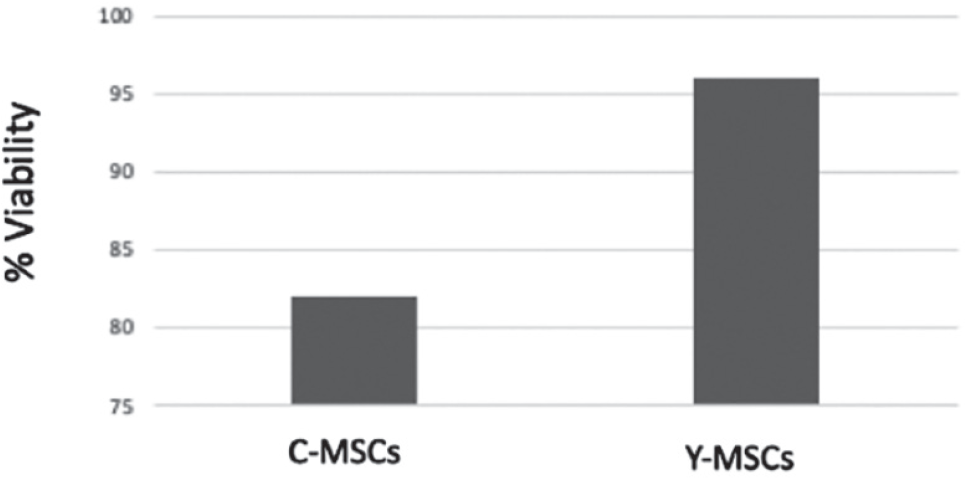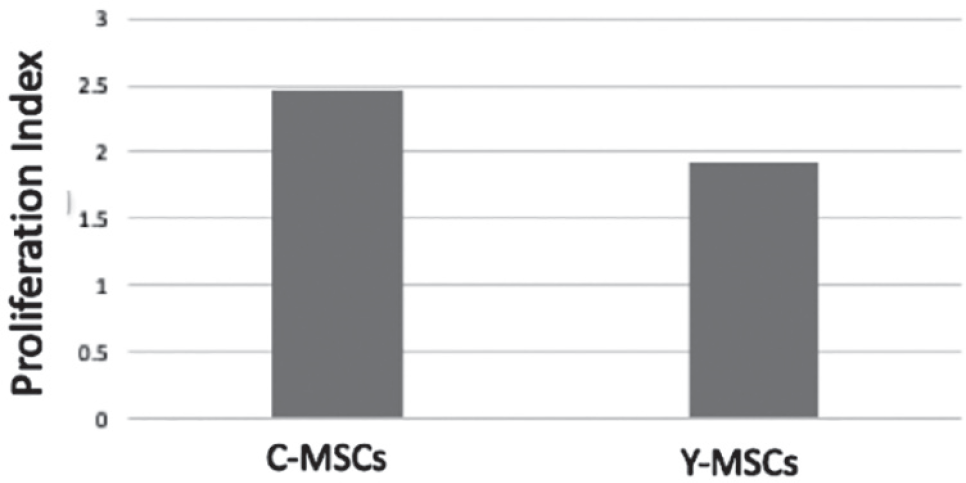
Integrative Medicine Case Reports, Volume 4, Issue 2 (July), 2023
Empowerment of Mesenchymal Stem Cells in a Yoga-Practicing Woman
KEY WORDS |
ABSTRACT |
|
Yoga
|
Mesenchymal Stromal/Stem (MSCs) cells possess a remarkable capacity as a therapeutic option for many diseases. These cells have immunomodulatory, proangiogenic, regenerative and anti-inflammatory capabilities. In spite of possessing such properties, these cells behave differently in the in-vivo environment in the diseased condition, and in many instances lose their therapeutic potential. This case report presents evidence about empowerment of MSCs from a pregnant woman who underwent a set of yogic exercises during her pregnancy. MSCs isolated from this woman were found to be in a better state post-cryopreservation, and also while mediating their immunomodulatory effect.
doi: 10.38205/imcr.040261 |
|
*Corresponding Author:
|
Introduction
Mesenchymal stem/stromal cells (MSCs) exhibit various properties like self-renewal capacity, multilineage differentiation, angiogenesis and immunomodulatory properties. These features make them an extremely promising tool for translational research and clinical applications. MSCs are found in various adult tissues and the cues in the micro niche dictate their fate and function (1,2). It is known that various categories of exercises can affect the extracellular matrix composition, inflammatory milieu, and such changes in the niche lead likely to the alteration of tissue-specific stem cell populations and their functions post-exercise (3–5). The clinical application strategies of mesenchymal stem cells are still evolving, and in spite of their extra ordinary properties, the deployment of MSCs is not completely reflected in the clinical trials (6).
The requirement of the MSCs to be cultured in vitro for upto 3–4 weeks for their cultivation and expansion may be a deterrent to the realization of some of their biological functions. Furthermore, harsh environment in vivo post-injection in the recipient in its diseased state leads to them having shorter life-span (7). Licensing and optimization of MSC culture conditions are key strategies to improving the MSC functions in vitro and in vivo. All of these procedures reportedly contribute to enhancing the MSC transplantation efficacy in tissue engineering and regenerative medicine (8).
In this report, we have analysed the MSCs from the Wharton’s jelly of a yoga-practising woman and found them to be possessing better properties. If tested and proved to be working in cells isolated from a larger sample size of yoga-practising pregnant women, such MSCs might be more effective when used for therapeutic purposes.
Yoga Protocol
The mother practised the yoga exercises as per (Table 1).
Table 1: Yogesta Protocol
| 2nd Trimester Practices, its sitting relaxation posture, Siddhasana instead of sitting relation posture, Siddhasana (60 minutes) | |
|---|---|
| Practices | Duration |
| Brief Invocation | 2 min |
| Head Stretch, Side stretch, Hand in/out | 1 min each |
| Loosening Fingers, Loosening wrist | 1 min each |
| Ankle stretch | 1 min |
| Neck exercises | 1 min |
| Quick relaxation technique (QRT) | 3 min |
| Side bending, Shoulder rotation | 1 min each |
| Twisting | ½ min |
| Instant Relaxation Technique (IRT) | 2 min |
| Tadasana (Initial Standing Posture), Ardhakati Cakrasana (Right Bending), Standing Relaxation Posture | 1 min each |
| Dandasna (Initial Sitting Posture), Vajrasana (Thunderbolt Pose), Vakrasna (side twist) | 1 min each |
| BadhaKonasana (Bound Angle Pose), Upavista Konasana (Wide angle seated forward bend) | 1 min each |
| Sitting Relaxation posture, Siddhasana (Perfect pose) | 1 min each |
| Deep Relaxation Technique (DRT) | 5 min |
| Savasana (left lateral position) | 2 min |
| Anulom Vilom (Alternative Nostril Breathing Technique) | 3 min |
| Sitali, Sitkari, Sadanta (Cooling Practices) | 3 min |
| Bhramari (bee breath) | 2 min |
| Abdominal, Thoracic and upper lobar | 1 ½ min each |
| Meditation | 10 min |
| Trataka (Trotter-meditation) | 2 min |
| Brief Invocation | 2 min |
| 3rd Trimester Practices (40 minutes) | |
| Brief Invocation | 2 min |
| Head Stretch, Side stretch, Hand in/out | 1 min each |
| Loosening Fingers, Loosening wrist | 1 min each |
| Ankle stretch, neck exercise, shoulder rotation | 1 min each |
| Instant Relaxation Technique (IRT) | 3 min |
| Anulom Vilom (Alternative Nostril Breathing Technique) | 3 min |
| Sitali, Sitkari, Sadanta (Cooling Practices) | 3 min |
| Bhramari (bee breath) | 2 min |
| Deep Relaxation Technique (DRT) | 5 min |
| Meditation | 10 min |
| Trataka (Trotter-meditation) | 2 min |
| Brief Invocation | 2 min |
Case Presentation
Isolation of Mesenchymal Stromal Cells
Human umbilical cord tissue was taken from the full-term birth of patient P1 from the Department of Obstetrics & Gynecology, PGIMER, Chandigarh (The patient’s consent was obtained and the respective approvals were taken from Institute ethics committee and Institute stem cell committee). P1 was 27 years in age and had no history of chronic infectious disease, STD or hepatitis. MSCs were isolated from the Wharton’s jelly (WJ-MSCs) from the umbilical cord tissue using standardized explant method. WJ pieces were washed with Phosphate-Buffered Saline (PBS), seeded in T-25 flasks and cultured in complete α-Minimum Essential Medium (Sigma AldrichTM). Cells were kept in an incubator with 5% CO2 at 37°C. After 70–80% confluence was achieved, cells were trypsinized and expanded till required passage number 2.
Characterization of MSCs
MSCs were characterized both phenotypically and functionally in accordance with the International Society for Cell Therapy (ISCT) guidelines (9). MSCs were phenotyped for standard markers including CD34, CD45, CD11b, CD19, HLA-DR, CD73, CD90, and CD105 (BD StemflowTM Human MSC Analysis Kit) through flow cytometry (BD FACS ARIA II). Cell count and viability were determined by staining with the Annexin-V kit (Sigma Aldrich), as per manufacturer’s protocol. Cells negative for annexin V and Propidium Iodide were counted and recorded as the viable population. MSCs were assessed for their multilineage differentiation potential to adipocyte, chondrocyte and osteogenic lineage.
Cryopreservation of MSCs
MSCs were cryopreserved in 10% Dimethyl Sulphoxide (DMSO) [Sigma AldrichTM] and 90% Fetal Calf Serum (FCS) [LONZATM] at 1°C/min cooling rate and stored in liquid nitrogen the following day. Their viability was analysed after 2 months.
Immunomodulatory Capacity of MSCs
Following the cryopreservation of two months, MSCs were analysed for their immunomodulatory capacity in a mixed lymphocyte reaction (MLR). CFSE (carboxyfluorescein succinimidyl ester) [Thermofisher ScientificTM] labelled responder cells (peripheral blood mononuclear cells - PBMCs) were co-culture with mitomycin inactivated stimulator cells at a cell number of 0.3 × 106 for each to induce lymphocyte proliferation. Unprimed MSCs (Control MSCs) or yoga-conditioned MSCs (Y-MSCs) were added to the MLR at a 1:10 ratio (MSC: PBMC). Co-cultures were incubated for four days at 37°C in a CO2 incubator, before analysing the proliferation of PBMCs in the cultures. The cell proliferation was analysed by acquiring the cells in flow cytometry and proliferation index was determined using Flow jo software.
MSCs stained with fluorochrome labelled antibodies showed >95% positivity for CD73, CD90 and CD105 in both the control MSCs (C-MSCs) and Y-MSCs (Figure 1). The pattern of both C-MSCs & Y-MSCs was similar for adipogenic, chondrogenic and osteogenic differentiation abilities.

Figure 1: Phenotypic characterisation of Y-MSCs: 100% positive expression of CD73, CD90 & CD105 as analysed by flow cytometry.
Interestingly, post cryopreservation the viability of Y-MSCs was 96% as compared to 82% viability of C-MSCs (Figure 2). Moreover, the proliferation index of PBMCs was significantly reduced in YMSCs group when compared to the unprimed group (Figure 3).

Figure 2: Comparison of viability of C-MSCs & Y-MSCs post cryopreservation for 2 months. The cells were stained with propidium iodide/annexin V and analysed by flow cytometry.

Figure 3: Comparison of responder PBMCs and their proliferation in response of C-MSCs & Y-MSCs. Flow cytometric analysis plots indication the percentage proliferation index of Responder cells, flow cytometry was performed on Day-5 post-coculture.
Discussion
Physical exercise and yogic kriyas have known beneficial effects on overall healthy being. Considering the cellular level, endogenous MSCs contribute to tissue homeostasis but are largely insufficient in case of severely damaged tissues. Therefore, developing MSC therapeutics holds great promise for the regeneration and immune modulation for various disease conditions. They display unique immunomodulatory properties due to the paracrine factors secreted by them (10). However, the complete efficacy of MSCs is not reflected adequately in terms of their clinical usage, and various regimens are being tried to license them to be functionally stable and more effective. They perform better if preconditioned in tailor made conditions according to the pathophysiology of the targeted diseased condition (11). Furthermore, for off-shelf supply, these cells have to be cryopreserved for on-demand availability. With the goal of understanding if yoga potentiates the capabilities of MSCs, this study was designed to understand the effect of cryopreservation on yoga-primed MSCs in terms of their viability and immunomodulation functional capacity. Various form of exercises have been reported to influence the biological properties of MSCs in various model systems (12–15), including their immunomodulation. Taken together, the results from our study provide a proof of concept indicating two significant findings which contribute to understanding the role of yoga in modulating properties of MSC. We propose that on account of having practiced a set of yoga exercises, the Y-MSCs revive in a better way with higher viability and, that the Y-MSCs become more potent immunomodulators.
Conclusion
This study forms a platform for testing the hypothesis in characterising WJ-MSCs from a larger cohort of yoga-practising pregnant women having genetic heterogeneity, and has implications in addressing pertinent issue of data gaps in the upcoming scientific field of evidence-based traditional medicine.
Authorsʼ contribution
D: Performed the experimental part and collected the sample; PN: Conducted Yoga Intervention in the Pregnant Women; AR: Conceived the idea, and guided the experimental plan.
Informed consent
The study was verbally explained to the patient and written consent was signed by the patient.
Source of funding
None.
Conflicts of interest
None.
Received Date: 27-03-23; Revised Date: 29-06-23
Accepted Date: 30-06-23
References
1. Uccelli A, Moretta L, Pistoia V. Mesenchymal stem cells in health and disease. Nat Rev Immunol. 2008;8(9):726–36. https://doi.org/10.1038/nri2395, PMID: 19172693
2. Ullah I, Subbarao RB, Rho GJ. Human mesenchymal stem cells – Current trends and future prospective. Biosci Rep. 2015;35(2). https://doi.org/10.1042/BSR20150025, PMID: 25797907.
3. Guzzoni V, Ribeiro MBT, Lopes GN, Marqueti Rde C, de Andrade RV, Selistre-de-Araujo HS, et al. Effect of resistance training on extracellular matrix adaptations in skeletal muscle of older rats. Front Physiol. 2018;11(9): 374. https://doi.org/10.3389/fphys.2018.00374, PMID: 29695977
4. Schmid M, Kröpfl JM, Spengler CM. Changes in Circulating Stem and Progenitor Cell Numbers Following Acute Exercise in Healthy Human Subjects: a Systematic Review and Meta-Analysis. Stem Cell Rev Rep. 2021;17(4):1091–1120. https://doi.org/10.1007/s12015-020-10105-7, PMID: 33389632
5. Cerqueira É, Marinho DA, Neiva HP, Lourenço O. Inflammatory effects of high and moderate intensity exercise—A systematic review. Front Physiol. 2020;9(10):1–14. https://doi.org/10.3389/fphys.2019.01550, PMID: 31992987
6. Galipeau J, Sensébé L. Mesenchymal stromal cells: clinical challenges and therapeutic opportunities. Cell Stem Cell. 2018;22(6):824–33. https://doi.org/10.1016/j.stem.2018.05.004, PMID 29859173.
7. Robey TE, Saiget MK, Reinecke H, Murry CE. Systems approaches to preventing transplanted cell death in cardiac repair. J Mol Cell Cardiol. 2008;45(4):567–81. https://doi.org/10.1016/j.yjmcc.2008.03.009, PMID 18466917.
8. Ullah M, Liu DD, Thakor AS. Mesenchymal stromal cell homing: mechanisms and strategies for improvement. iScience. 2019;15:421–38. https://doi.org/10.1016/j.isci.2019.05.004, PMID: 31121468
9. Dominici M, Le Blanc K, Mueller I, Slaper-Cortenbach I, Marini FC, Krause DS, et al. Minimal criteria for defining multipotent mesenchymal stromal cells. The International Society for Cellular Therapy position statement. Cytotherapy. 2006;8(4):315–7. https://doi.org/10.1080/14653240600855905, PMID 16923606.
10. Song N, Scholtemeijer M, Shah K. Mesenchymal stem cell immunomodulation: mechanisms and therapeutic potential. Trends Pharmacol Sci. 2020;41(9):653–64. https://doi.org/10.1016/j.tips.2020.06.009, PMID 32709406.
11. Hu C, Li L. Preconditioning influences mesenchymal stem cell properties in vitro and in vivo. J Cell Mol Med. 2018;22(3):1428–42. https://doi.org/10.1111/jcmm.13492, PMID 29392844.
12. Massoto TB, Santos ACR, Ramalho BS, Almeida FM, Martinez AMB, Marques SA. Mesenchymal stem cells and treadmill training enhance function and promote tissue preservation after spinal cord injury. Brain Res. 2020;17(26):1464–94. https://doi.org/10.1016/j.brainres.2019.146494, PMID 31586628.
13. de Souza Vieira S, de Melo BL, dos Santos LF, Cummings CO, Tucci PJF, Serra AJ. Exercise training in boosting post-mi mesenchymal stem cell therapy. Stem Cell Rev Rep. 2021;17(6):2361–3. https://doi.org/10.1007/s12015-021-10274-z, PMID 34608608.
14. Cucarián JD, Berrío JP, Rodrigues C, Zancan M, Wink MR, de Oliveira A. Physical exercise and human adipose-derived mesenchymal stem cells ameliorate motor disturbances in a male rat model of Parkinson’s disease. J Neurosci Res. 2019;97(9):1095–109. https://doi.org/10.1002/jnr.24442, PMID 31119788.
15. Zhang YX, Yuan MZ, Cheng L, Lin LZ, Du HW, Chen RH, et al. Treadmill exercise enhances therapeutic potency of transplanted bone mesenchymal stem cells in cerebral ischemic rats via anti-apoptotic effects. BMC Neurosci. 2015;16(1):56. https://doi.org/10.1186/s12868-015-0196-9, PMID 26342636.